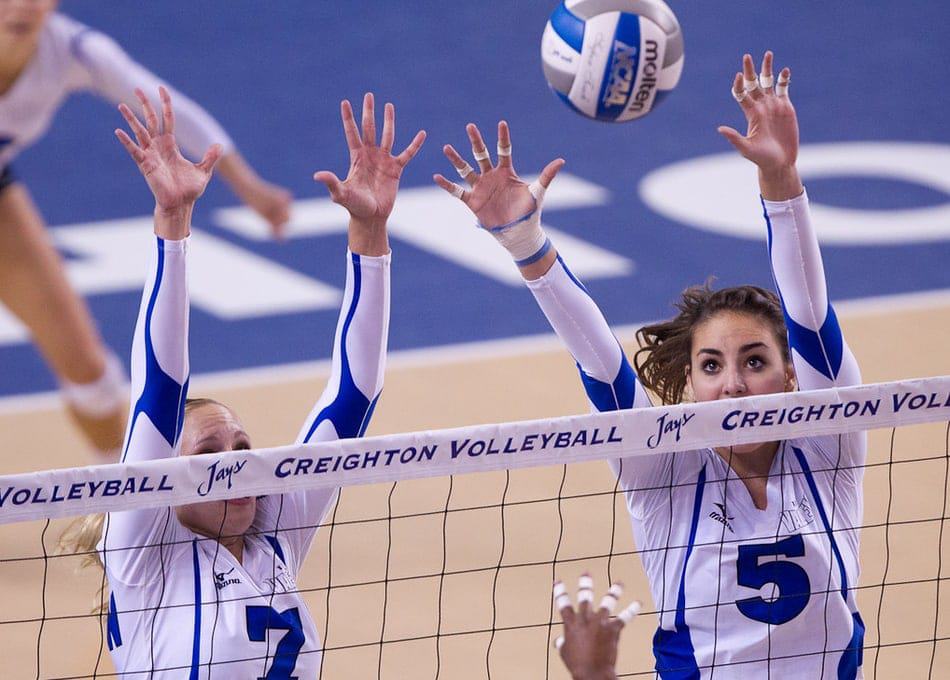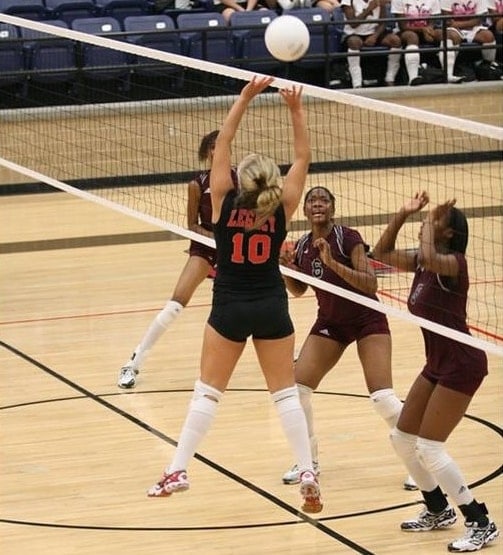In volleyball, a back row attack is when a player in the back row part of the rotation hits the ball over the net, from a height that is above the height of the net. In a standard volleyball formation, there are three players in the back row who are positioned behind the front row. These players aren’t allowed to attack the ball from in front of the attack line (also known as the ten-foot line or the three-meter line).
Back row attacks are usually done by a player approaching the ball from the back of the court and hitting it with a wrist snap or overhand swing. The player can jump over the line during the attack, but has to leave the floor from behind the line. Back row attacks can be used to change the rhythm and pace of the offense.

Back Row Attack Rules for Volleyball
Here are the rules for attacking from the back row in volleyball:
- Players are not allowed to attack the ball from the front row if they are in the back row.
- Players in the back row of the rotation are allowed to attack the ball if they jump from behind the attack line and may land in the front row, on the line, or in the back row.
- Players are not allowed to block or spike the ball while they are in the back row, unless they meet the conditions described in rule 2.
These rules are in place to prevent all the players on a team from being able to swarm the net and block and attack in an overwhelming way. Imagine trying to defend a team when the setter could set any of the other 5 players as they all approach the net! This rule makes for a more balanced and competitive game.
Would you like to shop for our favorite recommended player products? Choose the item below and click to shop on Amazon.
How is a Back Row Attack More Challenging?
A back row attack can be more challenging in volleyball for a few reasons:
- Spatial awareness: When you are hitting near the net, you have a reference for where you are in space, how high you are and where the boundaries are. You use your periferal vision to pick up on this information automatically. In the back row, these references are far, which makes them less helpful.
- Limited space: Players in the back row have less space to approach the ball and execute their attack, which can make it more difficult to generate power and control. Unless the attack was planned well ahead of time, the player often doesn’t know they should transition a little further back and make an approach, so they just jump, or take one step and jump.
- Less time to react: Players in the back row may have less time to react to the ball and set up for their attack, which can make it more challenging to execute a successful back row attack. Often, the setter will be changing the plan because of a weak pass and the back row player has little warning.
- Different angles: Players in the back row often have to hit the ball from different angles, which can make it more difficult to control the direction and trajectory of the ball. They lose the ability to hit at such an aggressive angle, because they are so far from the net.
- Opposing team’s defense: The opposing team is likely to be better prepared to receive and defend a back row attack because of the extra distance the ball will travel. This makes it less likely to score a kill.
Overall, back row attacks can be challenging because players in the back row have less space, time, and angle to work with, and they often have to overcome a strong defense in order to execute a successful attack.
Should You Block a Back Row Attack?
Blocking a back row attack in volleyball can be a useful strategy, but it really depends on the situation. Here are a few things to consider when deciding whether to block a back row attack:
- The location of the attacker: If the attacker is approaching the ball with the speed and height that is going to bring them close to the net, it may be more effective to block their attack.
- The location of your blockers: If you have blockers are already positioned near the net, it may be a good idea to have them attempt to block the attack.
- The skill level of the attacker: If the attacker is a strong hitter who is likely to hit the ball hard and accurately, it may be more effective to try to defend the attack rather than attempting to block it.
- The score and game situation: If the game is close and every point is important, it may be worth trying to block a back row attack in order to disrupt the opposing team’s offense.

Ultimately, the decision to block a back row attack should be based on the specific circumstances of the game and the strengths and weaknesses of your team. Blocking the back row attacks are much less likely to work, but sometimes it’s worth at least having one blocker as an obstacle to make the attacker try to hit past.
Can a Libero Make a Back Row Attack?
The libero is a purely defensive position in volleyball and is not allowed to hit an attack shot anywhere on the court. The only exception to this is when the libero serves, that can be considered an attack.
The libero is limited to only playing in the back row the entire time they are on the court, so they are never allowed up front to make an attack, or even to block. When you see the libero spike the ball, you’ll notice they don’t jump. In this way, they can’t be called for an attack, because by staying on the ground, their contact will not be made at a higher height than the net.
Would you like to learn more about the libero position? Check out this post: The Volleyball Libero
Can a Back Row Setter Dump in Volleyball?
Yes, a back row setter can dump the ball in volleyball, but they must do so very carefully. A “dump” refers to a situation where the setter hits the ball over the net for an attack, rather than setting the ball to a teammate for an attack.
Technically, this dump cannot be a strong forceful attack from above the height of the net. You may some dumps where a setter almost “slam dunks” the ball with their hand furthest from the net, this should be called a violation every time.
The legal dump from a back row setter will need to take place when a part of the ball and the player’s hand is below the plane of the net, OR the setter may dump in a way that it is a very soft and deceptive volley, that barely clears the net. In either of these cases, it does not qualify as an “attack.”

In general, setters are not expected to be strong attackers, so dumping the ball is not a common strategy. However, there are a few situations in which a back row setter might choose to dump the ball:
- If the opposing team is anticipating a set to the front row and is positioning themselves to strongly defend that attacker, the setter might choose to dump the ball to an open space as a surprise attack.
- If the pass to the setter is an “overpass” that comes close to going over the net and there isn’t a blocker ready and waiting on the other side, the setter may opt to just dump it.
- If the setter sees an opening in the opposing team’s defense and believes they can score a point with a dump, they might choose to go for it.
- If the setter is scrambling from a bad pass and there are no attackers available, they might choose to dump the ball as a last resort.
Overall, dumping the ball is not a common strategy in volleyball, but it can be a useful option in certain situations to score a suprise point or to change the pace of the attacks.
Is There a Hand Signal For Back Row Attacks?
In volleyball, there is no specific hand signal for a back row attack. Most hand signals in volleyball are only for use between rallies, so communication calling for an attack is usually handled verbally.
If the setter is going to set one of their back row players, they will call out the player’s name. If one of the back row players wants to call for a back row hit, they will call out “set me” or something similar to let their setter know they are ready. One of the most common back row plays, is for the setter to set the player who passed them the ball if the spacing and position on the court makes sense at the time and the player is a strong hitter, with good spatial awareness.
Have you ever wondered about the signals that beach volleyball players use and what they mean? Check out this article next.
Recent Posts
Athletes, listen up! Do you have a closet full of old jerseys, sweatpants, and tees that you just can't seem to part with? Well, dust them off, because you're sitting on a goldmine of fashion...
You may have heard, or you may have noticed, that there's been a change to the rule about double contact in volleyball. In 2022, an experimental rule change began to be implemented, where the double...
